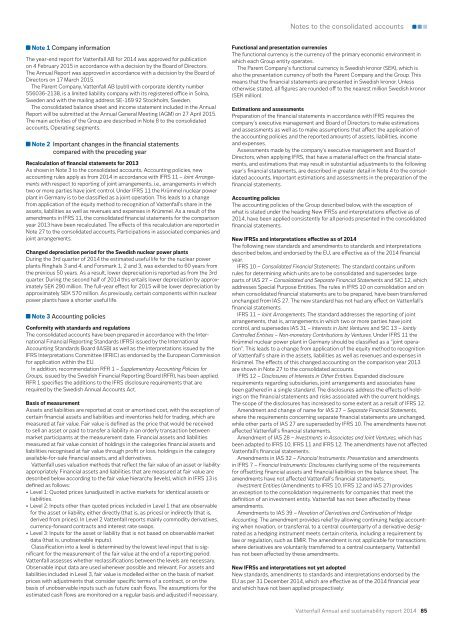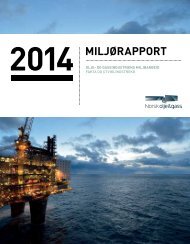annual-and-sustainability-report-2014
annual-and-sustainability-report-2014
annual-and-sustainability-report-2014
You also want an ePaper? Increase the reach of your titles
YUMPU automatically turns print PDFs into web optimized ePapers that Google loves.
Notes to the consolidated accountsNote 1 Company informationThe year-end <strong>report</strong> for Vattenfall AB for <strong>2014</strong> was approved for publicationon 4 February 2015 in accordance with a decision by the Board of Directors.The Annual Report was approved in accordance with a decision by the Board ofDirectors on 17 March 2015.The Parent Company, Vattenfall AB (publ) with corporate identity number556036-2138, is a limited liability company with its registered office in Solna,Sweden <strong>and</strong> with the mailing address SE-169 92 Stockholm, Sweden.The consolidated balance sheet <strong>and</strong> income statement included in the AnnualReport will be submitted at the Annual General Meeting (AGM) on 27 April 2015.The main activities of the Group are described in Note 8 to the consolidatedaccounts, Operating segments.Note 2 Important changes in the financial statementscompared with the preceding yearRecalculation of financial statements for 2013As shown in Note 3 to the consolidated accounts, Accounting policies, newaccounting rules apply as from <strong>2014</strong> in accordance with IFRS 11 – Joint Arrangementswith respect to <strong>report</strong>ing of joint arrangements, i.e., arrangements in whichtwo or more parties have joint control. Under IFRS 11 the Krümmel nuclear powerplant in Germany is to be classified as a joint operation. This leads to a changefrom application of the equity method to recognition of Vattenfall’s share in theassets, liabilities as well as revenues <strong>and</strong> expenses in Krümmel. As a result of theamendments in IFRS 11, the consolidated financial statements for the comparisonyear 2013 have been recalculated. The effects of this recalculation are <strong>report</strong>ed inNote 27 to the consolidated accounts, Participations in associated companies <strong>and</strong>joint arrangements.Changed depreciation period for the Swedish nuclear power plantsDuring the 3rd quarter of <strong>2014</strong> the estimated useful life for the nuclear powerplants Ringhals 3 <strong>and</strong> 4, <strong>and</strong> Forsmark 1, 2 <strong>and</strong> 3, was extended to 60 years fromthe previous 50 years. As a result, lower depreciation is <strong>report</strong>ed as from the 3rdquarter. During the second half of <strong>2014</strong> this entails lower depreciation by approximatelySEK 290 million. The full-year effect for 2015 will be lower depreciation byapproximately SEK 570 million. As previously, certain components within nuclearpower plants have a shorter useful life.Note 3 Accounting policiesConformity with st<strong>and</strong>ards <strong>and</strong> regulationsThe consolidated accounts have been prepared in accordance with the InternationalFinancial Reporting St<strong>and</strong>ards (IFRS) issued by the InternationalAccounting St<strong>and</strong>ards Board (IASB) as well as the interpretations issued by theIFRS Interpretations Committee (IFRIC) as endorsed by the European Commissionfor application within the EU.In addition, recommendation RFR 1 – Supplementary Accounting Policies forGroups, issued by the Swedish Financial Reporting Board (RFR), has been applied.RFR 1 specifies the additions to the IFRS disclosure requirements that arerequired by the Swedish Annual Accounts Act.Basis of measurementAssets <strong>and</strong> liabilities are <strong>report</strong>ed at cost or amortised cost, with the exception ofcertain financial assets <strong>and</strong> liabilities <strong>and</strong> inventories held for trading, which aremeasured at fair value. Fair value is defined as the price that would be receivedto sell an asset or paid to transfer a liability in an orderly transaction betweenmarket participants at the measurement date. Financial assets <strong>and</strong> liabilitiesmeasured at fair value consist of holdings in the categories financial assets <strong>and</strong>liabilities recognised at fair value through profit or loss, holdings in the categoryavailable-for-sale financial assets, <strong>and</strong> all derivatives.Vattenfall uses valuation methods that reflect the fair value of an asset or liabilityappropriately. Financial assets <strong>and</strong> liabilities that are measured at fair value aredescribed below according to the fair value hierarchy (levels), which in IFRS 13 isdefined as follows:• Level 1: Quoted prices (unadjusted) in active markets for identical assets orliabilities.• Level 2: Inputs other than quoted prices included in Level 1 that are observablefor the asset or liability, either directly (that is, as prices) or indirectly (that is,derived from prices). In Level 2 Vattenfall <strong>report</strong>s mainly commodity derivatives,currency-forward contracts <strong>and</strong> interest rate swaps.• Level 3: Inputs for the asset or liability that is not based on observable marketdata (that is, unobservable inputs).Classification into a level is determined by the lowest level input that is significantfor the measurement of the fair value at the end of a <strong>report</strong>ing period.Vattenfall assesses whether reclassifications between the levels are necessary.Observable input data are used whenever possible <strong>and</strong> relevant. For assets <strong>and</strong>liabilities included in Level 3, fair value is modelled either on the basis of marketprices with adjustments that consider specific terms of a contract, or on thebasis of unobservable inputs such as future cash flows. The assumptions for theestimated cash flows are monitored on a regular basis <strong>and</strong> adjusted if necessary.Functional <strong>and</strong> presentation currenciesThe functional currency is the currency of the primary economic environment inwhich each Group entity operates.The Parent Company’s functional currency is Swedish kronor (SEK), which isalso the presentation currency of both the Parent Company <strong>and</strong> the Group. Thismeans that the financial statements are presented in Swedish kronor. Unlessotherwise stated, all figures are rounded off to the nearest million Swedish kronor(SEK million).Estimations <strong>and</strong> assessmentsPreparation of the financial statements in accordance with IFRS requires thecompany’s executive management <strong>and</strong> Board of Directors to make estimations<strong>and</strong> assessments as well as to make assumptions that affect the application ofthe accounting policies <strong>and</strong> the <strong>report</strong>ed amounts of assets, liabilities, income<strong>and</strong> expenses.Assessments made by the company’s executive management <strong>and</strong> Board ofDirectors, when applying IFRS, that have a material effect on the financial statements,<strong>and</strong> estimations that may result in substantial adjustments to the followingyear’s financial statements, are described in greater detail in Note 4 to the consolidatedaccounts, Important estimations <strong>and</strong> assessments in the preparation of thefinancial statements.Accounting policiesThe accounting policies of the Group described below, with the exception ofwhat is stated under the heading New IFRSs <strong>and</strong> interpretations effective as of<strong>2014</strong>, have been applied consistently for all periods presented in the consolidatedfinancial statements.New IFRSs <strong>and</strong> interpretations effective as of <strong>2014</strong>The following new st<strong>and</strong>ards <strong>and</strong> amendments to st<strong>and</strong>ards <strong>and</strong> interpretationsdescribed below, <strong>and</strong> endorsed by the EU, are effective as of the <strong>2014</strong> financialyear.IFRS 10 – Consolidated Financial Statements. The st<strong>and</strong>ard contains uniformrules for determining which units are to be consolidated <strong>and</strong> supersedes largeparts of IAS 27 – Consolidated <strong>and</strong> Separate Financial Statements <strong>and</strong> SIC 12, whichaddresses Special Purpose Entities. The rules in IFRS 10 on consolidation <strong>and</strong> onwhen consolidated financial statements are to be prepared, have been transferredunchanged from IAS 27. The new st<strong>and</strong>ard has not had any effect on Vattenfall’sfinancial statements.IFRS 11 – Joint Arrangements. The st<strong>and</strong>ard addresses the <strong>report</strong>ing of jointarrangements, that is, arrangements in which two or more parties have jointcontrol, <strong>and</strong> supersedes IAS 31 – Interests in Joint Ventures <strong>and</strong> SIC 13 – JointlyControlled Entities – Non-monetary Contributions by Ventures. Under IFRS 11 theKrümmel nuclear power plant in Germany should be classified as a “joint operation”.This leads to a change from application of the equity method to recognitionof Vattenfall’s share in the assets, liabilities as well as revenues <strong>and</strong> expenses inKrümmel. The effects of this changed accounting on the comparison year 2013are shown in Note 27 to the consolidated accounts.IFRS 12 – Disclosures of Interests in Other Entities. Exp<strong>and</strong>ed disclosurerequirements regarding subsidiaries, joint arrangements <strong>and</strong> associates havebeen gathered in a single st<strong>and</strong>ard. The disclosures address the effects of holdingson the financial statements <strong>and</strong> risks associated with the current holdings.The scope of the disclosures has increased to some extent as a result of IFRS 12.Amendment <strong>and</strong> change of name for IAS 27 – Separate Financial Statements,where the requirements concerning separate financial statements are unchanged,while other parts of IAS 27 are superseded by IFRS 10. The amendments have notaffected Vattenfall’s financial statements.Amendment of IAS 28 – Investments in Associates <strong>and</strong> Joint Ventures, which hasbeen adapted to IFRS 10, IFRS 11 <strong>and</strong> IFRS 12. The amendments have not affectedVattenfall’s financial statements.Amendments in IAS 32 – Financial Instruments: Presentation <strong>and</strong> amendmentsin IFRS 7 – Financial Instruments: Disclosures clarifying some of the requirementsfor offsetting financial assets <strong>and</strong> financial liabilities on the balance sheet. Theamendments have not affected Vattenfall’s financial statements.Investment Entities (Amendments to IFRS 10, IFRS 12 <strong>and</strong> IAS 27) providesan exception to the consolidation requirements for companies that meet thedefinition of an investment entity. Vattenfall has not been affected by theseamendments.Amendments to IAS 39 – Novation of Derivatives <strong>and</strong> Continuation of HedgeAccounting. The amendment provides relief by allowing continuing hedge accountingwhen novation, or transferral, to a central counterparty of a derivative designatedas a hedging instrument meets certain criteria, including a requirement bylaw or regulation, such as EMIR. The amendment is not applicable for transactionswhere derivatives are voluntarily transferred to a central counterparty. Vattenfallhas not been affected by these amendments.New IFRSs <strong>and</strong> interpretations not yet adoptedNew st<strong>and</strong>ards, amendments to st<strong>and</strong>ards <strong>and</strong> interpretations endorsed by theEU as per 31 December <strong>2014</strong>, which are effective as of the <strong>2014</strong> financial year<strong>and</strong> which have not been applied prospectively:Vattenfall Annual <strong>and</strong> <strong>sustainability</strong> <strong>report</strong> <strong>2014</strong> 85



